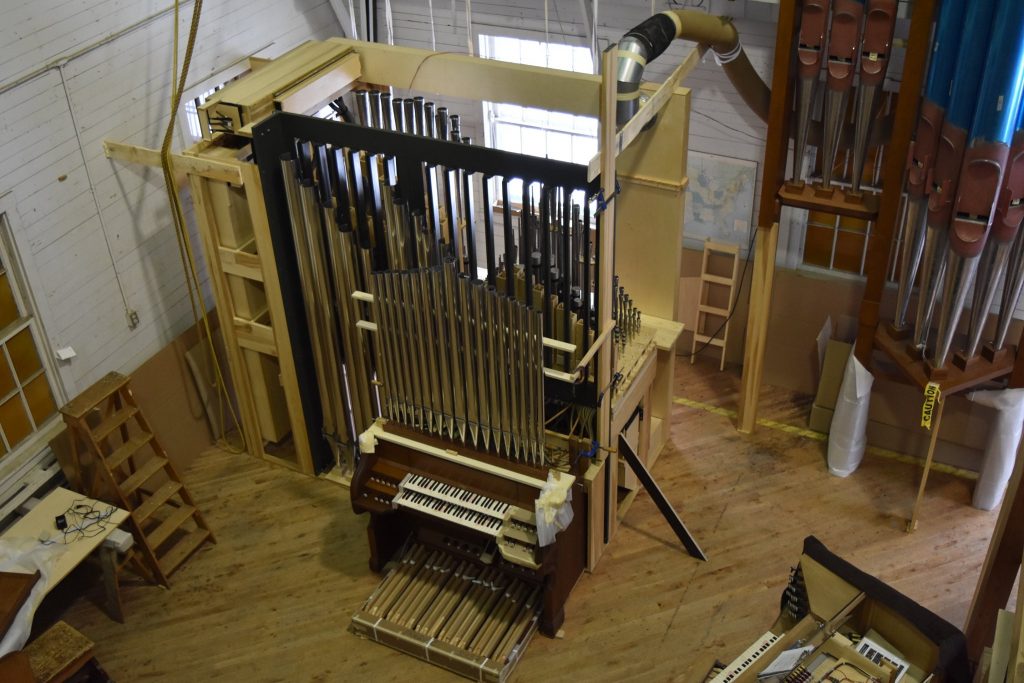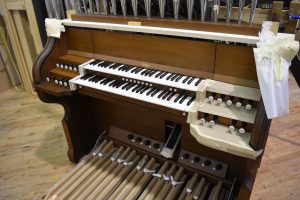
By Christopher Wells, Director of Music & Organist
View all the photos from the trip to Québec here
After nearly a decade of discussion and two years of intense planning, on Tuesday this week the new organ for St. Dunstan’s Chapel will arrive! Builders from Casavant Frères in Saint-Hyacinthe, Québec will take three weeks to install the instrument in the organ chamber at the side of the chapel and another two weeks to tune and voice the instrument in the chapel’s acoustics. This is Casavant’s 3837th instrument in their 140 years of organ-building. This is an exciting, once-in-a-generational moment for the church, and we are especially indebted to the project’s donors.
Earlier this month, I traveled to see and hear the new organ for St. Dunstan’s Chapel, in process at the factory of Casavant Frères in Saint-Hyacinthe, Québec. The final steps in the organ’s installation can occur only on site in Christ Church, so the organ was not quite complete. However, it was far enough along that we could inspect and play it in a preliminary fashion. Joining me on this trip was my colleague Nathan Costa and two project angels, Linda Jacob and Jennifer Umphress. Our Boston-based project adviser, Jonathan Ambrosino, drove up to join us.
The purpose of this trip was twofold: 1) acting as an owner representative, on behalf of Christ Church, I wanted to be sure the instrument met the terms of our contract; and 2) showing respect, consideration, and encouragement for the artisans who have labored for over a year to create this unique piece of art. Although aided by machine tools and computer design, organ-building remains a hand-craft discipline, in which construction, art, and music intersect, hopefully, to create a lasting and beautiful instrument.
Point by point, we reviewed the instrument in progress against our contract with Casavant Frères. In a pipe organ, even of this relatively small size, there are literally thousands of parts, some sourced from industry suppliers, but most made at Casavant. We found an organ in superb shape, with a fine action, beautiful woodworking, a solid supply of wind, and excellent engineering. Unsurprisingly, we found a few unresolved items, and together we left the Casavant team with a list of eight things to be addressed before the instrument is shipped to Bloomfield Hills. The brevity of our list is testimony to a company with 140 years of experience, knowledge, and ability to deliver a first-rate product. This is, after all, Casvant’s 3,837th instrument!



Regarding the new organ’s musical character, one could imagine a situation where thousands of parts are produced, the instrument makes “sound,” and the contract is satisfied in a checklist manner. Yet, this is only the beginning of what is, for me, the most fascinating part of an organ-building project. Considering only the pipes (more than 600 in this instrument), each has a myriad of adjustments that affect strength, timbre, attack, and decay. Adjusting the effect of one pipe can’t exist in a vacuum; each pipe must relate to all the other pipes in any given stop. In turn, each stop must make musical and aural sense to its sibling stops, both in “expected” ways (like oil and vinegar) but unusual and unexpected ways (like salt and caramel). It is a task demanding both specific attention to detail and a full understanding of the whole. Ideally, each pipe blends into beautiful stops that together fuse into a statement of timeless beauty and appropriateness.
Even in its preliminary state, the organ was making simply beautiful sounds, from the gentlest to the fullest. Like a house or a church, you can plan all you want, but to hear the first sounds is an especially soul-nourishing moment. We had substantive conversations about how this work will continue once the organ is installed in a chamber (in St. Dunstan’s Chapel), quite different than the vast set-up room at Casavant.
The new organ will arrive at Christ Church Cranbrook Tuesday, March 3. Installation is expected to take three weeks, followed by an additional two weeks of tonal finishing, in which the instrument’s sound is adjusted to blend appropriately with itself and adapted to the acoustics of the chapel. We are on schedule for dedication events beginning Sunday, May 17, 2020. (See reverse side for more information.)
Hearing and seeing the organ in person made me grateful afresh for the people who have given considerable financial support for this project, and especially for Linda, Barney, and Jennifer, who made the effort to come to Québec to make their acquaintance with the process that much more in-depth. Now, I feel they share even more excitement about this project than ever. Thanks be to God!